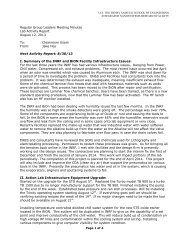Download Lab Safety Manual - Integrated Nanosystems Research ...
Download Lab Safety Manual - Integrated Nanosystems Research ...
Download Lab Safety Manual - Integrated Nanosystems Research ...
Create successful ePaper yourself
Turn your PDF publications into a flip-book with our unique Google optimized e-Paper software.
Classes of Chemicals that Can Form Peroxides Upon Aging:<br />
1. Class I<br />
Unsaturated materials, especially those of low molecular weight, may polymerize violently and<br />
hazardously due to peroxide initiation.<br />
Acrylic Acid<br />
Acrylonitrile<br />
Butadiene<br />
Chlorobutadiene<br />
(Chloroprene)<br />
Chlorotrifluoroethylene<br />
Methyl ethacrylate<br />
Styrene<br />
Tetrafluoroethylene<br />
Vinyl acetate<br />
Vinyl acetylene<br />
Vinyl chloride<br />
Vinyl chloride<br />
Vinyl pyridine<br />
Vinylidene Chloride<br />
2. Class II<br />
The following chemicals are a peroxide hazard upon concentration (distillation/evaporation). A test<br />
for peroxide should be performed if concentration is intended or suspected.<br />
Acetal<br />
Cumene<br />
Cyclohexene<br />
Cyclooctene<br />
Cyclopentene<br />
Diacetylene<br />
Dicyclopentadiene<br />
Diethylene Glycol<br />
Dimethyl Ether<br />
(Diglyme)<br />
Diethyl Ether<br />
Dioxane (p-Dioxane)<br />
Ethylene Glycol<br />
Dimethyl Ether<br />
Furan<br />
Methyl Acetylene<br />
Methyl Cyclopentane<br />
Methyl-i-butyl Ketone<br />
Tetrahydrofuran<br />
Tetrahydronathalene<br />
Vinyl Ethers<br />
3. Class III<br />
Peroxides derived from the following compounds may explode without concentration.<br />
Organic<br />
Divinyl Ether<br />
Divinyl Acetylene<br />
Isopropyl Ether<br />
Vinyliene Chloride<br />
Inorganic<br />
Potassium Metal<br />
Potassium Amide<br />
Sodium Amide<br />
55



